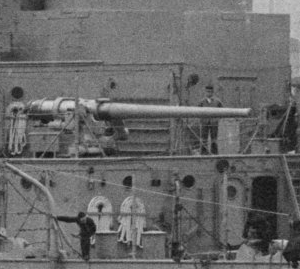5-inch/51-caliber gun
| 5"/51 caliber gun | |
|---|---|
 Gun on starboard forecastle of USS Texas, March 1914 | |
| Type | Naval gun Coastal defence Coast Guard gun |
| Place of origin | |
| Service history | |
| Used by | |
| Wars | World War I, World War II |
| Production history | |
| Variants | Mk 7, 8, 9, 14, 15 |
| Specifications | |
| Mass | 5 metric tons (5 long tons, 5.5 short tons) |
| Length | 21 ft 9 in (6.63 m) |
| Barrel length | 21 ft 1 in (6.43 m) bore (51 calibres) 17 ft 8 in (5.38 m) rifling |
| Shell | 50 to 55 pounds (22.7 to 24.9 kg)[1] |
| Caliber | 5 inches (127 mm) |
| Elevation | to +20° |
| Muzzle velocity | 3,150 feet per second (960 m/s) average |
5"/51 caliber guns (spoken "five-inch-fifty-one-caliber") formed the main battery of the first United States Navy light cruisers and the secondary batteries of United States Navy battleships built from 1907 through the 1920s. United States naval gun terminology indicates the gun fired a projectile 5 inches (127 mm) in diameter, and the barrel was 51 calibers long (barrel length is 5" × 51 = 255" or 6.4 meters).[2]
Description
The built-up gun consisted of a tube, full-length jacket, and single hoop with side swing Welin breech block and Smith-Asbury mechanism for a total weight of about 5 metric tons. Some Marks included a tapered liner. A 24.5-pound (11 kg) charge of smokeless powder gave a 50-pound (23 kg) projectile a velocity of 3,150 feet per second (960 m/s). Range was 15,850 yards (9.0 statute miles or 14.5 kilometres) at the maximum elevation of 20 degrees.[1] Useful life expectancy was 900 effective full charges (EFC) per liner.[3]
US service

The 5"/51 caliber gun was used to engage destroyers, torpedo boats and other surface targets. Increased awareness of the need for anti-aircraft protection (especially following the attack on Pearl Harbor) encouraged mounting of dual-purpose 5"/38 caliber guns in later battleships, and most of the World War 1-era battleships were rearmed with 5"/38 caliber guns during World War 2. Surplus guns from scrapped or re-armed battleships were mounted in United States Coast Guard cutters, auxiliaries, small aircraft carriers, coast defense batteries, and Defensively Equipped Merchant Ships.[3] A 1939 Table of Organization and Equipment shows Marine defense battalions were equipped with six of these guns each.[4] 5"/51 shore batteries were used with great effectiveness by the 1st Marine Defense Battalion during the Battle of Wake Island in December 1941. Six Tambor-class submarines were rearmed with "wet mount" 5"/51 guns taken from Barracuda-class submarines or spares for that class.
The 5"/51 caliber gun was mounted on:
- USS Olympia (C-6) - replacing 10 5"/40 and 4 8"/35 guns
- USS Chester (CL-1)[5] - replacing 2 5"/50 and 4 3"/50 guns
- USS Birmingham (CL-2)[5] - replacing 2 5"/50 and 4 3"/50 guns
- USS Salem (CL-3)[5] - replacing 2 5"/50 and 4 3"/50 guns
- USS Florida (BB-30)[6]
- USS Utah (BB-31)[6]
- USS Wyoming (BB-32)[7]
- USS Arkansas (BB-33)[7]
- USS New York (BB-34)[8]
- USS Texas (BB-35)[8]
- USS Nevada (BB-36)[9]
- USS Oklahoma (BB-37)[9]
- USS Pennsylvania (BB-38)[10]
- USS Arizona (BB-39)[10]
- USS New Mexico (BB-40)[11]
- USS Mississippi (BB-41)[11]
- USS Idaho (BB-42)[11]
- USS Tennessee (BB-43)[12]
- USS California (BB-44)[12]
- USS Colorado (BB-45)[13]
- USS Maryland (BB-46)[13]
- USS West Virginia (BB-48)[13]
- USS Barracuda (SS-163)[14]
- USS Bass (SS-164)
- USS Bonita (SS-165)[14]
- USS Langley (CV-1)[15]
- USS Long Island (CVE-1)[16]
- USS Sangamon (CVE-26)[17]
- USS Suwannee (CVE-27)[17]
- USS Chenango (CVE-28)[17]
- USS Santee (CVE-29)[17]
- USS Charger (CVE-30)[18]
- Template:Sclass-s[19]
- Template:Sclass-s
- Template:Sclass2-s[20]
- Template:Sclass-s[20] (USCG Lake class cutters)
- Template:Sclass-s[20]
British service
During World War I three of these guns formed part of the coastal defences of Scapa Flow.[1] In World War II a small number of these guns entered British service on board ships transferred under the Lend-lease arrangement. Some of these guns were then transferred to New Zealand and deployed ashore for coast defense.[1]
Notes
- ^ a b c d Tony DiGiulian, "United States of America 5"/51 (12.7 cm) Marks 7, 8, 9, 14 and 15. British 5"/51 (12.7 cm) BL Marks VI and VII
- ^ Fairfield 1921 p. 156
- ^ a b Campbell 1985 p.136
- ^ Bogart, Charles H., "Fifth Marine Defense Battalion in Iceland", Coast Defense Journal, Vol. 29, Issue 3, August 2015, Coast Defense Study Group, Inc.
- ^ a b c Preston 1980 p. 60
- ^ a b Breyer 1973 p. 201
- ^ a b Breyer 1973 p. 202
- ^ a b Breyer 1973 p. 205
- ^ a b Breyer 1973 p. 210
- ^ a b Breyer 1973 p. 214
- ^ a b c Breyer 1973 p. 219
- ^ a b Breyer 1973 p. 226
- ^ a b c Breyer 1973 p. 230
- ^ a b Fahey 1939 p. 18
- ^ Fahey 1939 p. 7
- ^ Friedman 1983 p. 162
- ^ a b c d Friedman 1983 p. 407
- ^ Friedman 1983 p. 164
- ^ Friedman 1983 p. 170
- ^ a b c Fahey 1941 p. 42
References
- Breyer, Siegfried (1973). Battleships and Battle Cruisers 1905–1970. Doubleday and Company. ISBN 0-385-07247-3.
- Campbell, John (1985). Naval Weapons of World War Two. Naval Institute Press. ISBN 0-87021-459-4.
- Fahey, James C. (1939). The Ships and Aircraft of the U.S. Fleet. Ships and Aircraft.
- Fahey, James C. (1941). The Ships and Aircraft of the U.S. Fleet, Two-Ocean Fleet Edition. Ships and Aircraft.
- Fairfield, A.P. (1921). Naval Ordnance. The Lord Baltimore Press.
- Friedman, Norman (1983). U.S. Aircraft Carriers. Naval Institute Press. ISBN 0-87021-739-9.
- Preston, Anthony (1980). Cruisers. Prentice Hall. p. 60. ISBN 0-13-194902-0.
